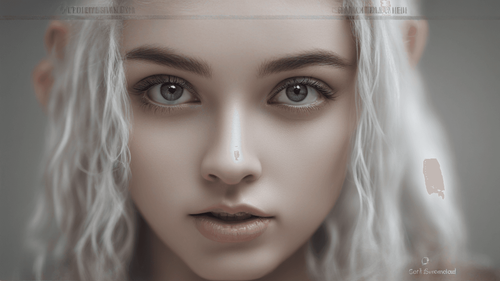
Introduction
In the ever-evolving landscape of technology, artificial intelligence (AI) has taken center stage, showcasing its prowess in a myriad of applications. One of the most captivating and transformative advancements is the creation of AI generated human images. This groundbreaking technology has not only redefined the way we perceive artificial intelligence but has also opened new avenues of creativity and innovation. In this comprehensive article, we delve deep into the realm of AI generated human images, exploring its significance, methodologies, challenges, and potential impacts.
AI Generated Human Images: A Glimpse into the Future
As we navigate the vast domain of AI, it's essential to understand the nuances of AI generated human images. These images are the result of intricate algorithms and neural networks that mimic human features, expressions, and emotions. The AI technology responsible for this marvel has the potential to revolutionize various industries, from entertainment and marketing to healthcare and beyond.
The Inner Workings of AI Generated Human Images
The creation of AI generated human images is a multifaceted process that involves several intricate steps. At its core, deep learning models, such as Generative Adversarial Networks (GANs), are employed. GANs consist of two neural networks – a generator and a discriminator – working collaboratively to create highly authentic human-like images.
Advancing Realism: Machine Learning and AI
AI generated human images owe their astonishing realism to the convergence of machine learning and AI technologies. The use of vast datasets containing diverse human facial features allows AI models to grasp the intricacies of human appearance. By analyzing these datasets, AI systems learn to replicate minute details, such as skin texture, hair color, and even imperfections, resulting in images that are virtually indistinguishable from actual human portraits.
Applications of AI Generated Human Images
The potential applications of AI generated human images are as diverse as they are exciting. Industries across the board are harnessing this technology to unlock new avenues of creativity, efficiency, and engagement.
Gaming and Virtual Realities: A Paradigm Shift
The gaming industry has embraced AI generated human images to propel immersive experiences to new heights. Virtual characters with lifelike expressions and emotions enhance players' engagement, blurring the line between reality and the digital realm.
Marketing and Advertising: Crafting Authentic Narratives
In the realm of marketing and advertising, AI generated human images enable brands to create relatable, authentic characters that resonate with their target audiences. This personalized approach enhances brand-consumer relationships and fosters emotional connections.
Healthcare and Medical Simulations: Training for Excellence
Medical professionals are leveraging AI generated human images to simulate complex medical scenarios, enabling realistic training for doctors, surgeons, and healthcare practitioners. This technology enhances medical education and empowers professionals to make informed decisions in critical situations.
Challenges and Ethical Considerations
While the potential of AI generated human images is awe-inspiring, it's essential to address the challenges and ethical dilemmas that accompany this technology.
Bias and Diversity Concerns
AI models are only as unbiased as the data they're trained on. Concerns regarding representation and diversity arise when AI generated human images predominantly reflect a specific demographic. Addressing bias in AI algorithms is crucial to ensure fair and accurate portrayals.
Privacy and Consent: Navigating Uncharted Waters
The creation of AI generated human images raises pertinent questions about privacy and consent. As AI technology becomes more adept at generating realistic images, distinguishing between real and AI-generated individuals could become increasingly challenging.
Misuse and Deceptive Intent
The astounding realism of AI generated human images also brings to light the potential for misuse. The technology could be exploited for malicious purposes, such as creating deepfake content with harmful intent.
FAQs about AI Generated Human Images
How do AI models learn to generate human-like images?
AI models learn to generate human-like images through a process called deep learning. They analyze vast datasets containing human facial features and use complex algorithms to replicate these features with remarkable accuracy.
Can AI generated human images replace real human models in various industries?
While AI generated human images offer incredible potential, they cannot entirely replace real human models. Human authenticity, emotions, and creativity remain invaluable in certain contexts.
Are there any copyright concerns associated with AI generated images?
Yes, copyright concerns can arise when AI generates images that closely resemble existing copyrighted content. The legal implications surrounding AI-generated images are still evolving.
How can businesses ensure ethical use of AI generated human images?
Businesses should prioritize transparency and disclosure when using AI generated human images. Additionally, adopting guidelines and industry best practices for ethical AI use is crucial.
What role does data quality play in the realism of AI generated human images?
Data quality significantly impacts the realism of AI generated human images. High-quality, diverse datasets contribute to creating images that closely mimic real human features.
What does the future hold for AI generated human images?
The future of AI generated human images is brimming with possibilities. As technology advances, we can expect even more realistic and ethically conscious applications across various sectors.
Conclusion
In the realm of artificial intelligence, the creation of AI generated human images stands as a testament to human ingenuity and innovation. This technology exemplifies the convergence of AI, machine learning, and creativity, offering a glimpse into a future where the boundaries between real and virtual are seamlessly intertwined. As we tread this path of progress, it's imperative to approach AI generated human images with a balanced perspective, harnessing their potential while addressing ethical considerations. With responsible development and conscientious utilization, AI generated human images have the power to reshape industries, enrich experiences, and leave an indelible mark on the tapestry of technological evolution.